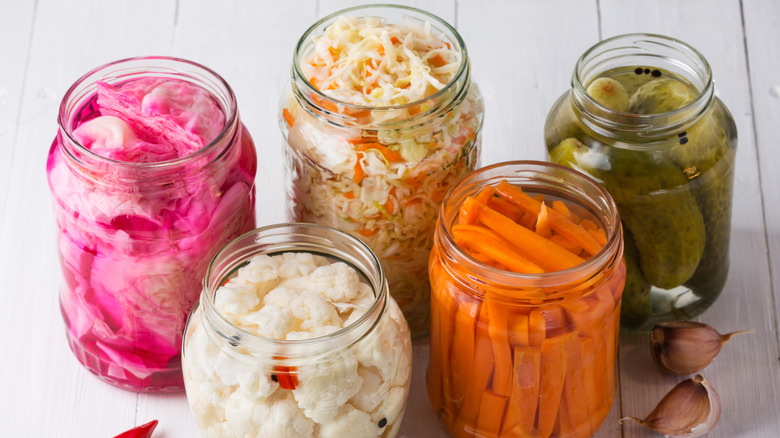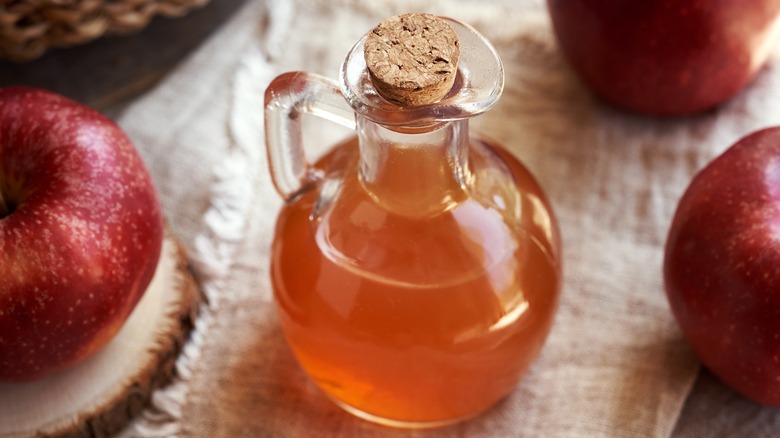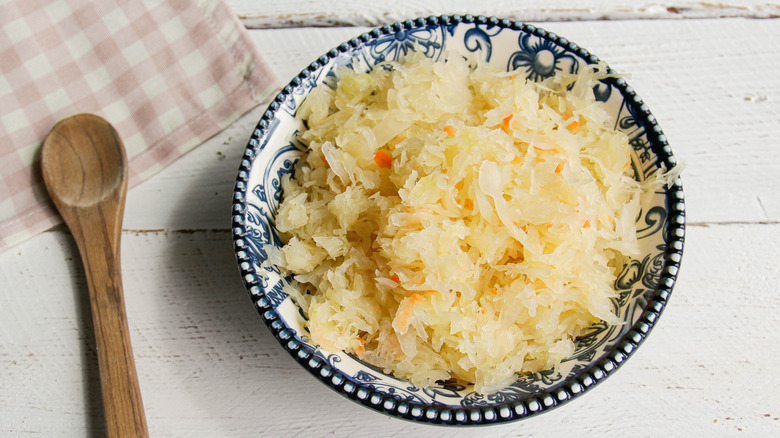What Is Fermentation And What Does It Really Do To Food?
There are probably some foods that will immediately come to mind when you hear the word "fermentation." Kimchi, sauerkraut, kombucha, and sourdough are all well known for the bright, tangy taste provided by the fermentation process. But flavor isn't all that fermentation offers, and the practice is far more widespread than you might think. Grapes become wine through fermentation, and cacao pods transform into chocolate. The process has been used for more than 10,000 years, because not only do fermented foods take on new textures, tastes, and qualities, but they also have a longer shelf life. And all it takes is microorganisms to break down carbs.
Well, okay, it's a bit more complicated than that (as most culinary biological processes are). But in a very general way, fermentation is microorganisms, like different types of bacteria or yeast, breaking down starches or sugar, turning them into acids or alcohols, and producing carbon dioxide. There are a lot of variables within that broad definition, and when you mix them up, you'll get three different types of fermentation.
A fermentation definition in three parts
The first is alcoholic fermentation, which, perhaps unsurprisingly, results in the alcohols that we love to sip — beer, wine, and even hard liquor (although that's just the pre-distillation part of that process). It begins with either commercial or natural yeast, which will produce heat and carbon dioxide, while it eats the sugars in the grapes or grains and turns them into alcohol. If you add oxygen and acetic acid bacteria to that alcohol, the process then becomes acetic fermentation, resulting in carbon dioxide and acetic acid — which is better known as vinegar.
Lactic acid fermentation is probably the type of fermentation you would envision when you hear the word. In extremely simplified terms, it involves an anaerobic environment (one that lacks free oxygen) in which lactic acid bacteria consume carbs and churn out lactic acid, carbon dioxide, and ethanol. The strains of lactic acid bacteria and the carbs that they digest are widespread; depending on those ingredients, this fermentation process could produce anything from kimchi and kombucha to sourdough and salami to cheese and yogurt. So if you're resolving to eat more fermented foods, it won't be difficult to find something delicious.
Practicalities behind the practice's popularity
The tangy and delicious results of fermentation are only part of the reason that it is such an ancient, culturally diverse, and persistently popular culinary preparation. It is particularly useful as a way to extend the shelf life of foods — some bacteria or yeast species will stop unwelcome yeasts and bacteria from developing, thus slowing down food's spoiling. How slow that spoilage becomes will be greatly dependent on the food itself, but the fermented food will last longer than its raw ingredient counterpart.
Beyond the deliciousness and durability, some studies have shown that certain fermented foods may have added health benefits, and these ancient foods are good for the modern gut. Although not all fermented food contains probiotics — some processes take away this good bacteria or render it dormant — many fermented ingredients retain them and their advantages. These probiotics can keep gut bacteria healthy and stable and help some digestive issues, which may also strengthen your immune system. They've also been linked to increases in mental and heart health. So those cravings for tangy, funky, fermented flavors won't just satisfy your tastebuds, and you've got plenty of reasons to add more fermented foods to your diet.


